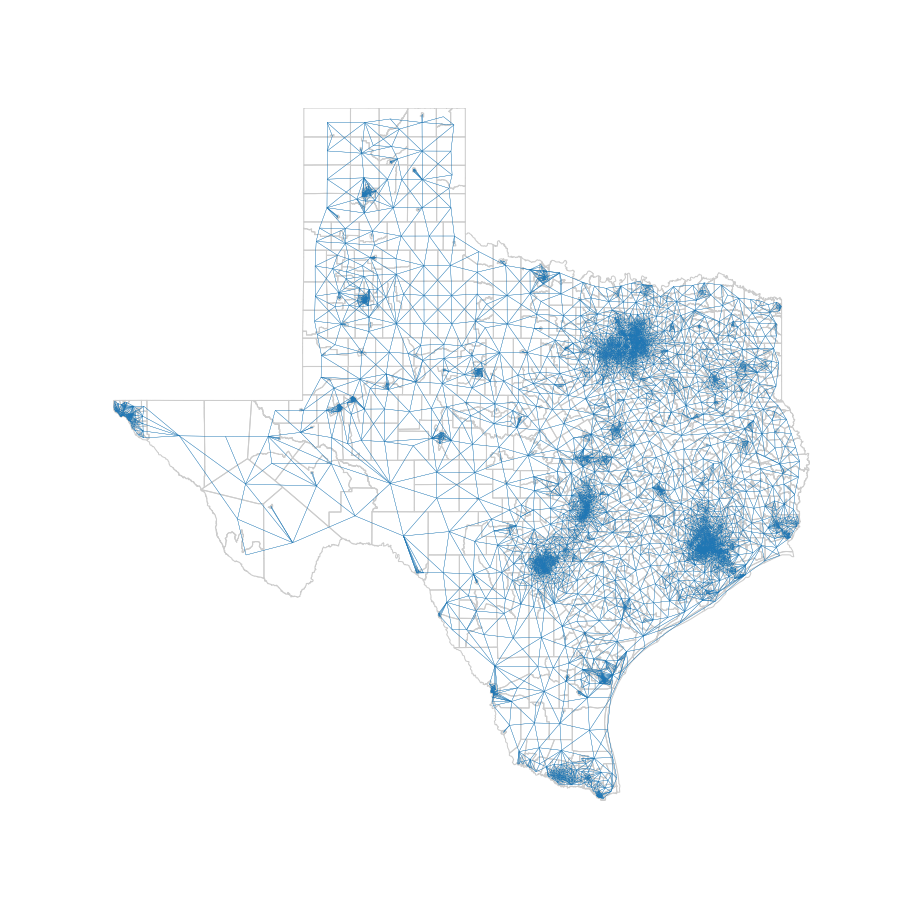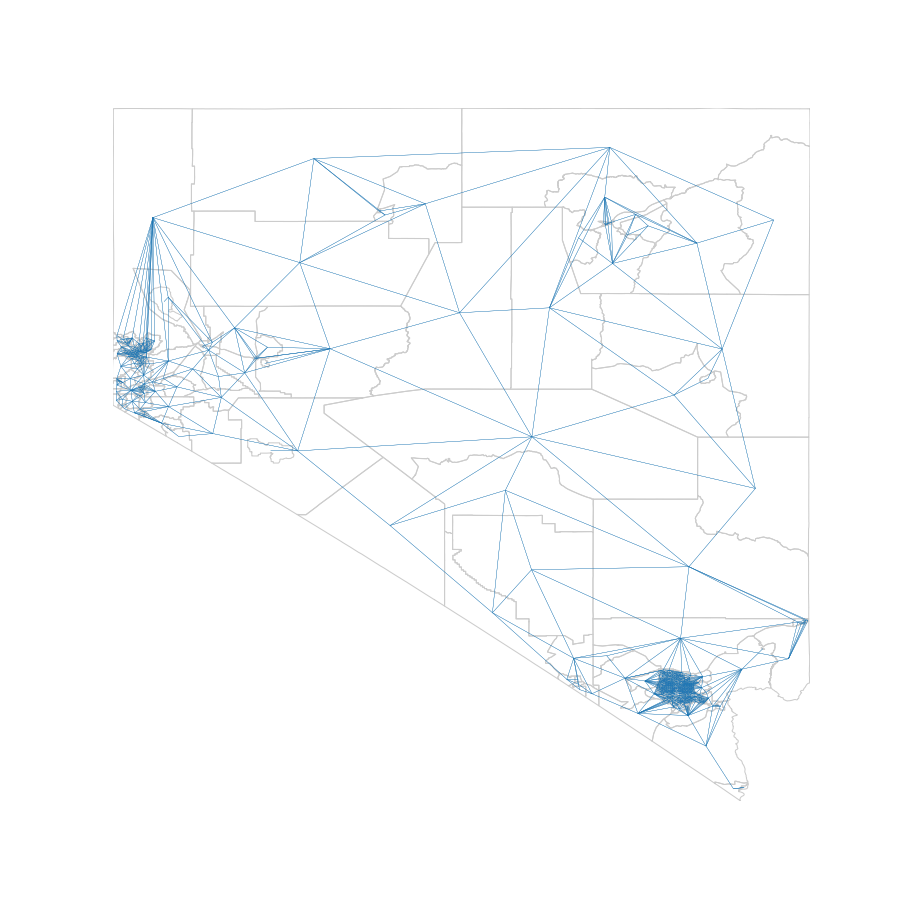Geometric Compactness Scores for Political Redistricting (MIT CSAIL + Tufts Metric Geometry and Gerrymandering Group)
Designed geometric compactness score for gerrymandering in political redistricting based on Polsby-Popper score. Research Assistantship MIT CSAIL: Developed a high-performance geometric data processing library for scientific computing over GIS data (shapefiles) in Python. Researched and implemented high performance geometric data processing algorithms for political redistricting. Scaled polygon adjacency algorithms for big data geospatial analysis.
The code used in this project was used to create adjacency graphs and other data structures to model relationships between congressional districts, census tracts, and other census units and subunits. The main functions which can be executed using the code in this project are: creating adjacency graphs & matrices, visualizing these data structures, and computing compactness scores and other measures using member and border nodes. The code is also specifically adapted to working with census data and includes ways of labeling and identifying entries based on GEOIDs. The main and most useful functions have been formalized and documented in district_node_computation_library.py
These instructions will get you a copy of project code up and running on your machine for development, data analysis, and testing purposes.
The following software needs to be installed on your machine. Instructions for installation are included and/or linked to in this section.

You will also need to install the following packages to run the code in this project:
- PySAL
- PyLAB
- Glob
- Collections
- shapely
The recommended method of installation is using Python pip. For instructions on installing python packages using pip, see the instructions linked to below.
Installing pip: https://pip.pypa.io/en/stable/installing/
Installing packages using pip: https://packaging.python.org/guides/installing-using-pip-and-virtualenv/
Installing PySAL and PySAL documentation: http://pysal.readthedocs.io/en/latest/users/installation.html
This section describes the code included in this project and possible uses. The code described is in the 'adjacency_graphs_all' folder of the repository.
 The above image is a visualization for the adjacency graphs of the tracts within the states of Texas. The code discussed in this portion can be used to create adjacency graphs for census tracts, blocks and other state sub-units. In implementation, some code shared in the 2014 scipy conference was used. See below for details.
The above image is a visualization for the adjacency graphs of the tracts within the states of Texas. The code discussed in this portion can be used to create adjacency graphs for census tracts, blocks and other state sub-units. In implementation, some code shared in the 2014 scipy conference was used. See below for details.
The function used to generate adjacency graphs is 'mggg_twostep' and it can be found in 'district_node_computation_library.py'. It implements the "twostep" algorithm discussed in "Scaling Polygon Adjacency Algorithms to Big Data Geospatial Analysis" by Jason Laura and Sergio J. Rey. As input, it requires a python dictionary who's values are PySAL geometries. To generate such a dictionary from a .shp file and a .dbf file, one could use 'create_polymap', which is found in the same library. The workflow to create an adjacency graph is then:
shp_dir = "path/to/some/shp/file.shp"
dbf_dir = "path/to/corresponding/dbf/file.shp"
id_column = "ID"
"""
ID should be the column name associated with the identifier one wishes to use for
the data. In the case of census data, it is common to use geographic identifiers,
usually labeled as "GEOID".
"""
polymap = create_polymap(shp_dir, dbf_dir, geoid_column)
adjacency_graph = mggg_twostep(polymap)
'visualize_adjacency_graph' will output a visualized adjacency graph for an shp file, such as the one below (generated using an shp file for the census tracts of Nevada).

The two computations of interest for this section are the number of member and boundary sub-units for a particular congressional district. Sub-unit here can refer to tracts, blocks, or block groups. The library has one function, 'get_district_member_and_boundary_entities' outputting two lists of lists for both of these computations. Potential data which can be used for such an analysis is discussed in the Data section.
Other code in 'adjacency_graphs_all' includes scripts used to perform the computations and generate graphs discussed in the previous sections. The functionalities of these scripts are implemented in the functions in 'district_node_computation_library.py'.
The data analyzed using this code was 2013 congressional district TIGER/LINE data and 2010 Census TIGER/LINE data. While accessing the Cartographic Boundary Shapefiles for individual districts via the census website (https://www.census.gov/geo/maps-data/data/cbf/cbf_cds.html) is fairly straightforward, this is harder, if possible, to do for tracts and other Census units. The method used by the team for acquiring this data was accessing the census ftp server at: ftp://ftp2.census.gov/ . Note, however, that the data should also be accessible via web at: https://www2.census.gov/ .
Instructions on how to access an ftp server via the command-line can be found in the following link: http://www.dummies.com/software/how-to-use-ftp-from-terminal-to-transfer-mac-files/
To access congressional district shapefile data via the ftp server, use the following lines from your command-line (note this would work for OSX/Linux Operating Systems).
ftp ftp://ftp2.census.gov/
> cd geo/tiger/TIGER2013/cd
from here, desired data can be downloaded following the instructions in the previous section.
ftp ftp://ftp2.census.gov/
> cd geo/tiger/TIGER2010/TRACT/2010
from here, desired data can be downloaded following the instructions in the previous section.
Alejandro Velez
Sarah Von Ahn (note a lot of the code not discussed in the readme belongs to her)
Justin Solomon - supervisor
Moon Duchin, Mira Bernstein - MGGG project
Gabriel Ramirez, Ria Das - fellow undergraduate researchers
Richard Barnes - helped with understanding how to access census data
